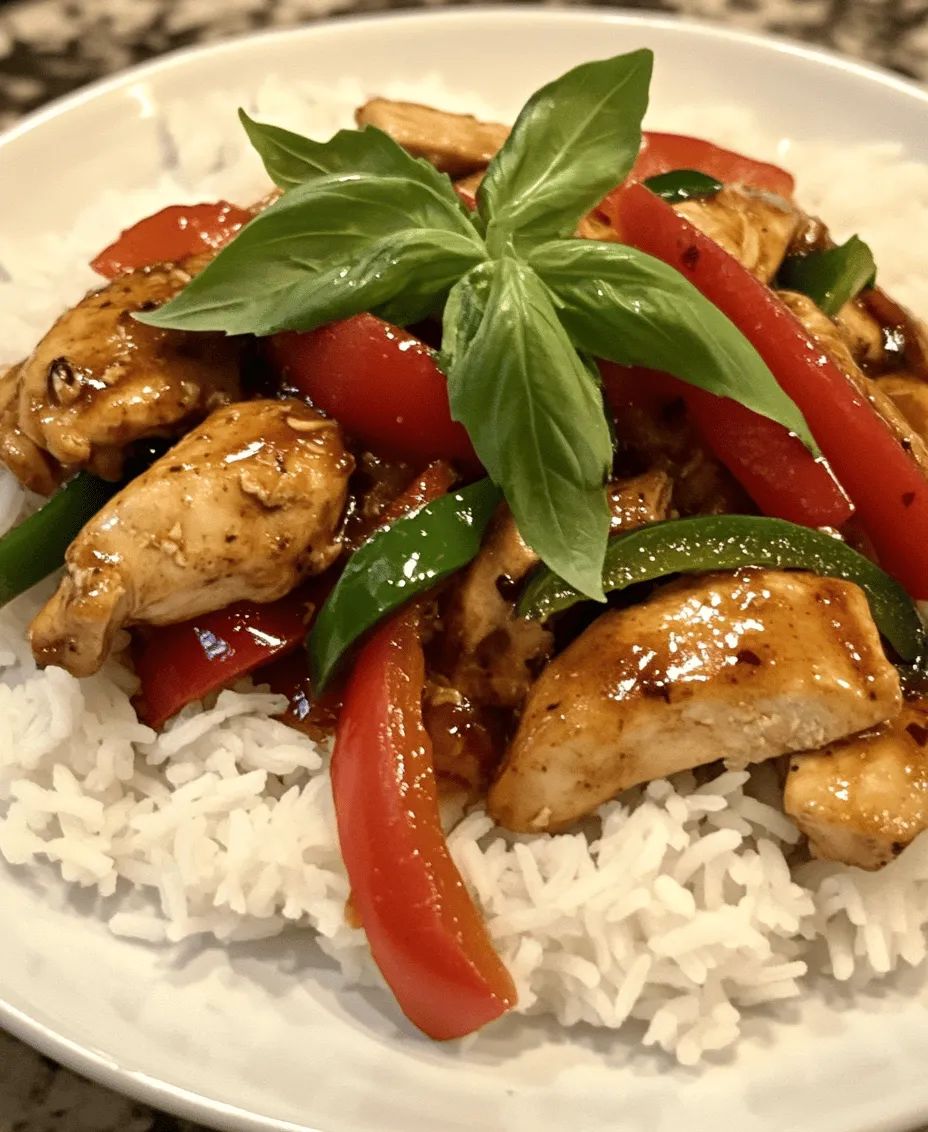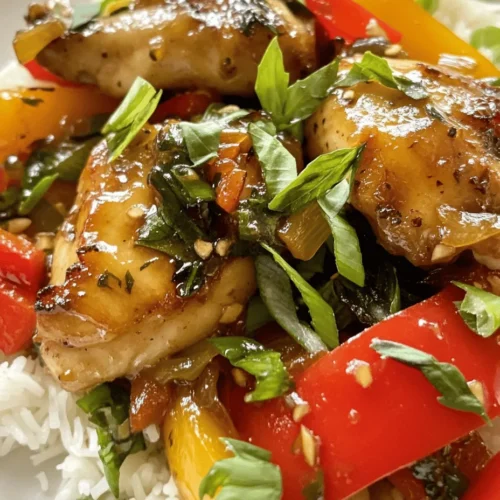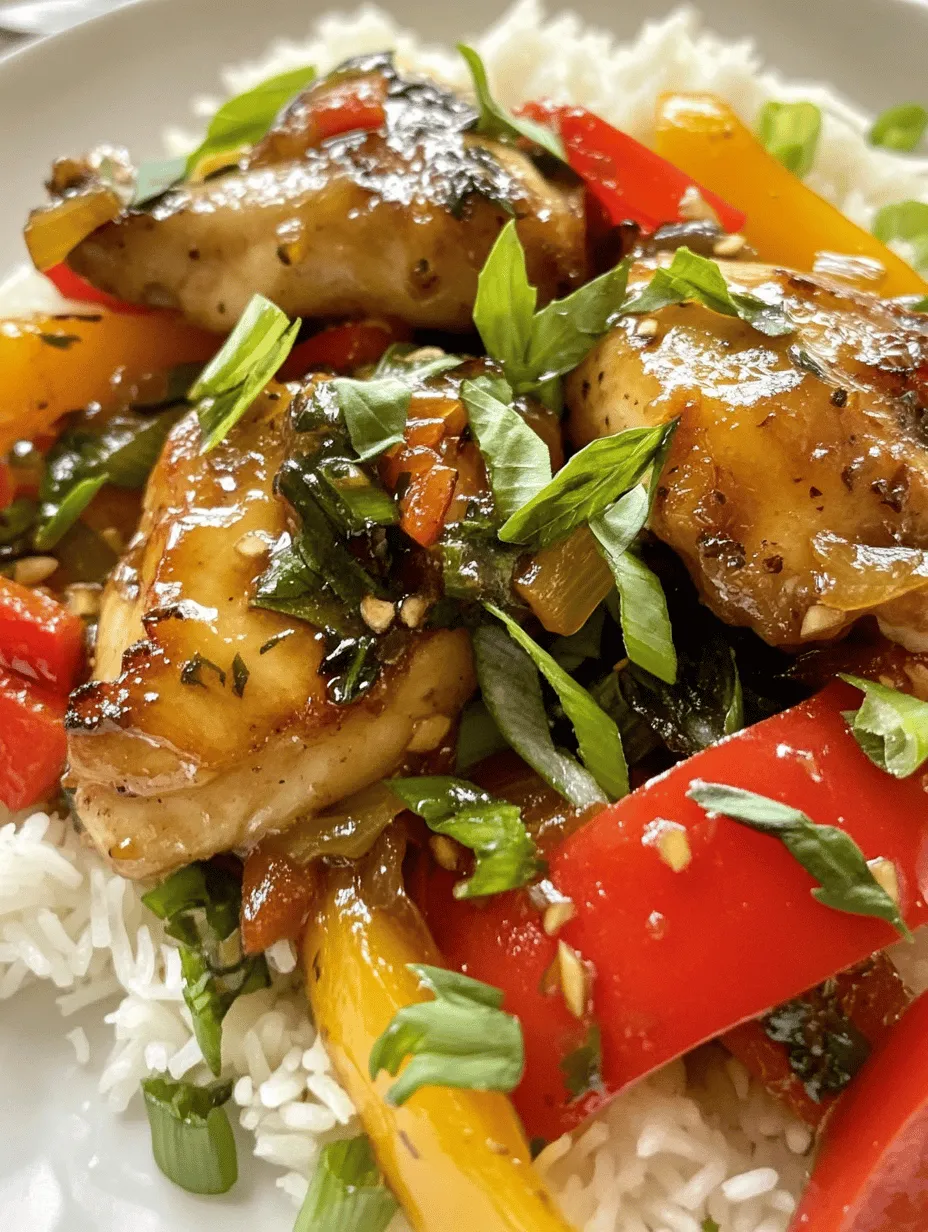Introduction
Thai cuisine has captured the hearts and palates of food lovers worldwide with its vibrant flavors, aromatic spices, and diverse ingredients. From the rich curries of the south to the fresh salads of the north, Thai food is all about balance—sweet, salty, sour, and spicy. One dish that encapsulates this balance beautifully is Sweet and Spicy Thai Chicken. This recipe is not just a meal; it’s an experience that brings together the boldness of Thai cooking with the comfort of home-cooked food.
The Sweet and Spicy Thai Chicken recipe stands out for its perfect harmony of flavors. The sweetness from honey, combined with the heat from chili garlic sauce, creates a deliciously addictive coating on tender, juicy chicken. This dish is not only flavorful but also incredibly easy to prepare, making it suitable for weeknight dinners or even special occasions. Whether you’re hosting a dinner party or simply enjoying a cozy evening at home, this recipe is sure to impress.
Using fresh ingredients is crucial in Thai cooking, as they enhance the dish’s overall flavor profile. Fresh herbs, vibrant vegetables, and quality protein are essential for achieving that authentic Thai taste. Plus, this Sweet and Spicy Thai Chicken recipe is quite versatile—feel free to serve it over jasmine rice, toss it in a salad, or enjoy it in a wrap. It’s a dish that adapts to your preferences and can be customized to suit your dietary needs.
Understanding the Ingredients
To create a truly delicious Sweet and Spicy Thai Chicken, understanding each ingredient’s role in the recipe is essential. Here’s a detailed breakdown of the components that make this dish so special.
Boneless Chicken Thighs
While chicken breasts may be the go-to choice for many recipes, boneless chicken thighs are the star of this dish. Thighs are inherently juicier and more flavorful due to their higher fat content. This fat renders during cooking, keeping the meat moist and tender, which is particularly important in a dish like this where the chicken is cooked quickly over high heat. The result is succulent pieces of chicken that absorb the flavors of the marinade beautifully.
Vegetable Oil
Using vegetable oil is key when cooking this dish. High-heat cooking methods, such as sautéing or stir-frying, require an oil with a high smoke point to prevent burning and maintain flavor integrity. Vegetable oil is ideal due to its neutral flavor and high smoke point. It allows the other ingredients to shine without imparting any unwanted taste, ensuring a perfect base for sautéing the chicken and aromatics.
Garlic and Ginger
Garlic and ginger are essential aromatics in Thai cooking, each contributing unique flavors and health benefits. Garlic adds a robust, savory depth to the dish, while ginger brings a warm, zesty kick that enhances the overall flavor profile. Both ingredients are rich in antioxidants and have anti-inflammatory properties, making them not only flavorful but also beneficial for health. When sautéed, they release aromatic oils that fill the kitchen with mouthwatering scents, setting the stage for a delectable meal.
Bell Peppers and Onion
Bell peppers and onions provide a wonderful contrast in texture and flavor. Bell peppers, especially red and yellow varieties, offer sweetness and crunch, while onions add a savory depth to the dish. Both vegetables are rich in vitamins C and A, making them nutritious additions to your meal. When cooked, they soften and caramelize, enhancing their natural sweetness and complementing the spiciness of the chicken.
Soy Sauce, Honey, Rice Vinegar, Fish Sauce, and Chili Garlic Sauce
These key sauces are the backbone of the dish’s sweet and spicy flavor balance.
– Soy Sauce: A staple in many Asian cuisines, soy sauce adds a savory umami depth, enhancing the overall flavor of the chicken.
– Honey: This natural sweetener not only balances the heat from the chili garlic sauce but also helps in caramelizing the chicken, creating a beautiful glaze.
– Rice Vinegar: Its mild acidity cuts through the richness of the dish, adding a subtle tang that brightens the flavors.
– Fish Sauce: A quintessential ingredient in Thai cooking, fish sauce lends a salty, umami flavor that rounds out the dish. A little goes a long way, so use it sparingly to avoid overwhelming other flavors.
– Chili Garlic Sauce: This sauce delivers the heat and adds complexity with its garlicky undertones. Adjust the amount according to your spice preference.
Cornstarch
Cornstarch plays a crucial role in achieving the perfect sauce consistency. When mixed with the marinade, it helps to thicken the sauce as it cooks, creating a luscious glaze that clings to the chicken. This step is essential for ensuring that every bite is packed with flavor and that the dish has a pleasing mouthfeel.
Fresh Basil and Green Onions
Finally, the addition of fresh herbs elevates this dish to another level. Fresh basil brings an aromatic, slightly sweet flavor that is unmistakably Thai. It adds brightness and freshness to the dish, balancing the richness of the chicken and sauces. Green onions, or scallions, are used as a garnish, adding a pop of color and a mild onion flavor that complements the other ingredients beautifully.
Preparation Steps in Detail
Now that we’ve explored the ingredients, let’s delve into the preparation steps to create this Sweet and Spicy Thai Chicken.
Marinating the Chicken
Marination is a vital step that enhances the chicken’s flavor. To start, cut the boneless chicken thighs into bite-sized pieces and place them in a bowl. Prepare your marinade by mixing together soy sauce, honey, rice vinegar, fish sauce, and chili garlic sauce in a separate bowl. Add a tablespoon of cornstarch to the marinade to help thicken the sauce later. Once thoroughly mixed, pour the marinade over the chicken, ensuring each piece is well-coated.
For optimal flavor absorption, let the chicken marinate for at least 30 minutes. If time allows, consider marinating it for several hours or even overnight in the refrigerator. The longer the chicken sits in the marinade, the more flavorful it will become. This step is crucial for developing depth in the dish and ensuring every bite is bursting with flavor.
Sautéing Aromatics
Once the chicken is marinated, it’s time to sauté the aromatics. Heat about two tablespoons of vegetable oil in a large skillet or wok over medium-high heat. It’s important to let the oil heat up sufficiently before adding the garlic and ginger to avoid burning them. When the oil is shimmering, add minced garlic and ginger.
Sauté the garlic and ginger for about 30 seconds to one minute, stirring constantly to prevent burning. You want to achieve a fragrant, golden brown color without letting them turn dark. This step is crucial, as burnt garlic and ginger can impart a bitter flavor to the dish.
Cooking the Chicken
Next, add the marinated chicken to the skillet. Spread the chicken in an even layer and allow it to sear without moving it for a few minutes. This will help achieve a nice golden brown color, which adds to the overall flavor and presentation of the dish. Once the chicken is browned on one side, stir-fry it for an additional 4-5 minutes until the chicken is cooked through and no longer pink in the center.
As the chicken cooks, it will release juices that will mix with the marinade, creating a delicious sauce. If the mixture seems too thick, you can add a splash of water or chicken broth to loosen it up. Once the chicken is fully cooked, taste the sauce and adjust the seasoning if necessary. You may want to add more soy sauce for saltiness or honey for sweetness, depending on your preference.
In the next part of the article, we will explore how to finish this dish, including adding vegetables and garnishing it for presentation. Stay tuned for more tips and tricks to elevate your Sweet and Spicy Thai Chicken experience!

Incorporating Vegetables
When preparing your Sweet and Spicy Thai Chicken, the timing for adding vegetables is crucial to ensure they retain their crunch and nutrients. Start by selecting a variety of colorful vegetables that will not only enhance the dish’s visual appeal but also contribute to its flavor profile. Common choices include bell peppers, snap peas, broccoli, and carrots.
Once your chicken is nearly cooked through (about 5-6 minutes into the stir-frying process), it’s the perfect time to add your vegetables. This allows them to cook just enough to maintain their vibrant colors and crisp textures without becoming mushy. Stir-fry the vegetables alongside the chicken for an additional 2-3 minutes. This timing ensures that they absorb the flavors of the sauce while still providing that satisfying crunch that complements the tender chicken. Remember, the goal is to achieve a balance of textures, so keep an eye on your vegetables and remove them from the heat as soon as they are crisp-tender.
Thickening the Sauce
Achieving the desired sauce thickness is an essential part of perfecting your Sweet and Spicy Thai Chicken. The cornstarch slurry method is a simple but effective technique that will give your sauce a glossy finish and the right consistency.
To create the slurry, mix equal parts cornstarch and cold water in a small bowl. Start with about 1 tablespoon of cornstarch and 1 tablespoon of water, whisking until smooth. Once your chicken and vegetables are cooked and your sauce is simmering, gradually stir in the cornstarch slurry. Continue stirring for about 1-2 minutes until the sauce thickens to your liking. If you find the sauce too thick, simply add a bit of water or chicken broth to reach your preferred consistency. This technique not only enhances the dish’s mouthfeel but also helps the sauce cling beautifully to the chicken and vegetables.
Serving Suggestions
The Sweet and Spicy Thai Chicken pairs wonderfully with jasmine rice or rice noodles, both of which complement the dish’s rich flavors and provide a satisfying base. Jasmine rice, known for its fragrant aroma and slightly sticky texture, absorbs the sauce beautifully, creating a delightful culinary experience. Alternatively, rice noodles offer a chewy texture that contrasts well with the tender chicken and crisp vegetables.
For an attractive presentation, serve your Sweet and Spicy Thai Chicken in a shallow bowl over a bed of rice or noodles. Garnish the dish with fresh basil and finely chopped green onions. The bright green colors not only enhance the visual appeal but also add fresh herbal notes that elevate the overall flavor. Adding a sprinkle of sesame seeds can provide an extra layer of texture and flavor, making your dish not just delicious but visually stunning as well.
To customize your Sweet and Spicy Thai Chicken, consider adding different vegetables or proteins. For example, tofu is a fantastic vegetarian option that absorbs the flavors of the sauce beautifully. You can also incorporate vegetables like zucchini, baby corn, or mushrooms to add diversity. Experimenting with these variations allows you to adapt the dish to your personal taste and dietary preferences.
Nutritional Information
Understanding the nutritional benefits of your Sweet and Spicy Thai Chicken is essential for maintaining a balanced diet. Each serving of this dish provides a healthy dose of protein from the chicken, which is vital for muscle repair and growth. Additionally, the inclusion of vegetables adds vitamins and minerals that support overall health. For instance, bell peppers are rich in vitamin C, while broccoli is packed with fiber and antioxidants.
In terms of macronutrients, this dish strikes a good balance between carbohydrates, fats, and proteins. The jasmine rice serves as a source of carbohydrates, providing energy for the day, while the chicken contributes lean protein. The sauce, primarily made from honey and soy sauce, adds a touch of sweetness but can also introduce sugars. To make the dish healthier, consider reducing the amount of sugar in the sauce or opting for a low-sodium soy sauce to cut down on sodium intake without sacrificing flavor.
Cultural Significance of Thai Cuisine
Thai cuisine is celebrated worldwide for its vibrant flavors and balance of ingredients. Rooted in a rich cultural context, Thai cooking emphasizes harmony among the four primary taste profiles: sweet, salty, sour, and spicy. This balance is a hallmark of Thai culinary philosophy and is evident in dishes like Sweet and Spicy Thai Chicken.
Historically, Thai food has been influenced by various cultures, including Indian, Chinese, and Malay cuisines, leading to a unique fusion of flavors and cooking techniques. The emphasis on fresh herbs, spices, and local ingredients reflects the agricultural bounty of Thailand, where meals are often prepared with seasonal produce.
In Sweet and Spicy Thai Chicken, the interplay of sweet honey, salty soy sauce, and the spicy kick from chili peppers embodies this balance. Each bite offers a complex flavor experience that delights the palate and showcases the essence of Thai cooking. By preparing this dish at home, you not only indulge in its deliciousness but also engage with the rich cultural heritage of Thailand.
Conclusion
In summary, the Sweet and Spicy Thai Chicken is a delightful dish that combines vibrant flavors, nutritious ingredients, and a glimpse into Thai culinary traditions. The careful incorporation of vegetables, the thickening of the sauce using cornstarch, and the thoughtful presentation create a meal that is both satisfying and visually appealing.
This dish is perfect for family dinners, gatherings, or meal prep, offering a balance of flavors that appeals to a wide range of palates. Whether you serve it over jasmine rice or rice noodles, Sweet and Spicy Thai Chicken is sure to be a hit at your dinner table. So, gather your ingredients and explore the exciting world of Thai cuisine right in your kitchen. Enjoy the process, savor the flavors, and make this delicious dish a staple in your culinary repertoire.



